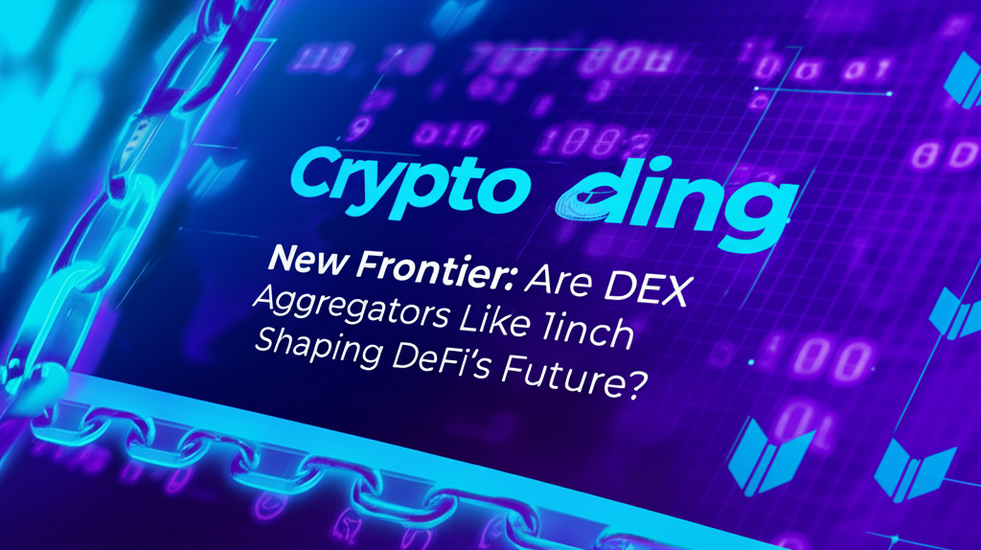Crypto Trading’s New Frontier: Are DEX Aggregators Like 1inch Shaping DeFi’s Future?

Decentralized exchange (DEX) aggregators represent a significant evolution in the crypto trading sphere, gathering liquidity from numerous DEXs to secure better prices and minimize costs for users. As this sector gains momentum, platforms like 1inch are emerging as pivotal players.
These platforms tackle common decentralized finance (DeFi) pain points like high fees and slippage by routing trades through the most efficient paths available across the fragmented DEX landscape. Data indicates the total trading value facilitated by DEX aggregators reached $2.03 billion by February 2025, signaling strong potential for expansion within the digital asset market.
1inch, a prominent DEX aggregator founded in May 2019 by Sergej Kunz and Anton Bukov, exemplifies this trend. Originating from a hackathon project, the platform has grown significantly, now optimizing trades across over 400 liquidity sources spanning 12 different blockchains. To date, it has processed a staggering $500 billion in cumulative volume.
Co-founder Sergej Kunz highlighted the platform’s ambition to transcend its DeFi roots and provide a user experience on par with centralized exchanges, but with the crucial benefits of non-custodial asset control. Key focus areas include enhancing DeFi capabilities, integrating support for major blockchains like Bitcoin and Solana, improving user experience (UX), and leveraging AI.
“The experience is continuously improving,” Kunz stated. “In a few years, we anticipate a seamlessness comparable to centralized exchanges, combined with the advantages of self-custody and atomic execution.”
Atomic execution is crucial in DeFi, ensuring that multi-step transactions either complete entirely or fail altogether, leaving no room for partial execution. This protects users from potential losses due to incomplete trades or detrimental activities like MEV (Maximal Extractable Value) bot interference, which can exploit pending transactions.
Kunz explained that 1inch utilizes atomic execution to bundle complex trade routes across multiple DEXs into single, indivisible blockchain transactions. If any part fails, the entire operation reverts, safeguarding user funds.
As an aggregator, 1inch scans numerous DEXs to find optimal rates for any given trade, using smart contracts to execute swaps based on user-defined parameters. “We developed an intent-based protocol where users simply state their desired outcome, and the execution details are handled by market makers and routing algorithms,” Kunz elaborated.
“We’ve extended this with cross-chain swaps, transforming 1inch into a cross-chain marketplace for all users,” he added.
The market capitalization for DEX aggregator tokens stood at $2.5 billion as of January 2025, with leading coins including Jupiter (JUP), 1inch (1INCH), and Cetus Protocol (CETUS). Competition is intensifying as the potential to trade tokenized traditional assets like securities on-chain attracts more development.
To maintain its edge, 1inch introduced Fusion+, an upgrade to its Swap Engine designed for more efficient cross-chain swaps using intent-based architecture and advanced bridging technology. This aims to access broader Web3 liquidity while enhancing security against front-running, securing better prices for users, particularly those utilizing the native Chi token for gas fee optimization.
Fusion+ has already processed over $200 million in cross-chain volume since its beta launch, according to Kunz, with integrations like ZKsync bolstering performance.
The platform is now prioritizing integration with non-EVM blockchains like Bitcoin (BTC) and Solana (SOL) to enhance interoperability. Bridging assets like Bitcoin to EVM-compatible chains (where over $100 billion in TVL was concentrated as of April 2025) without wrapping presents significant technical hurdles due to architectural differences.
These challenges limit Bitcoin’s direct use in popular Ethereum-based DeFi applications. reliance on wrapped tokens (like WBTC) positions BTC as a secondary asset, and developers face increased complexity managing multiple bridges and token variants.
Beyond crypto-native expansion, 1inch is exploring partnerships with traditional finance (TradFi) institutions. Kunz envisions bringing banks and other financial players into the DeFi ecosystem, fostering institutional adoption through DeFi-native solutions.
“Our value proposition lies in self-custody and atomic execution. We believe TradFi needs to adapt to our technology, not the other way around, because it’s unique,” Kunz asserted.
Security remains a paramount concern. Kunz detailed 1inch’s approach, involving the aggregation of security services to monitor wallets involved in illicit activities. “We integrate services that track fund laundering and block interactions via our APIs for flagged wallets,” he said, suggesting this could attract more institutional participants seeking compliant solutions.
Looking ahead, asset tokenization emerges as a major growth area. Kunz views the tokenization of real-world assets (RWAs) like stocks and securities as a logical next step for 1inch.
He predicts that within five to ten years, users will trade traditional assets on-chain with non-custodial control, transcending geographical limits and leveraging atomic execution. A joint report by Ripple and BCG projects the asset tokenization market could reach $18.9 trillion by 2033, up from its current estimated size of $600 billion.
Despite this potential, Kunz expressed concerns about the current lack of robust secondary markets for tokenized RWAs within the DeFi space.
“There isn’t a unified place to find the best execution for these assets yet,” Kunz noted. “That’s the gap 1inch aims to fill. We are building that platform. The potential is enormous.”
